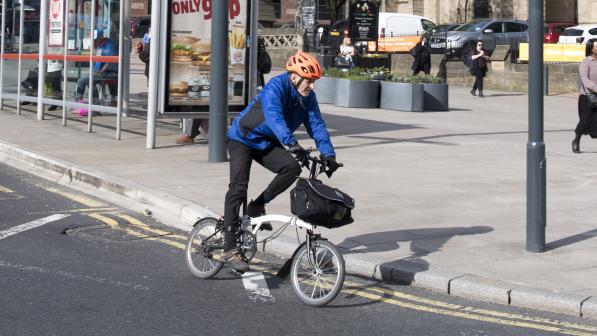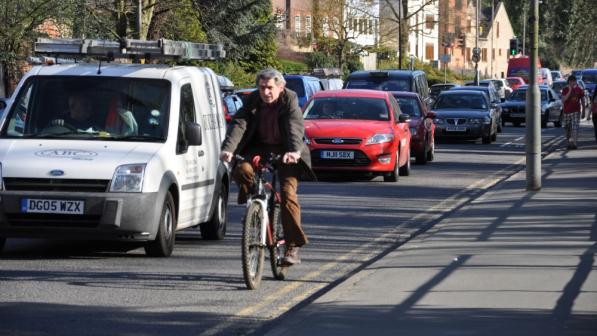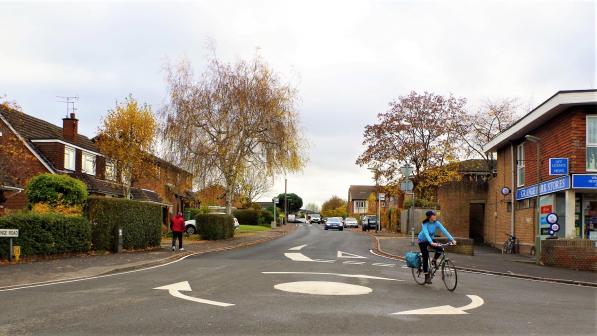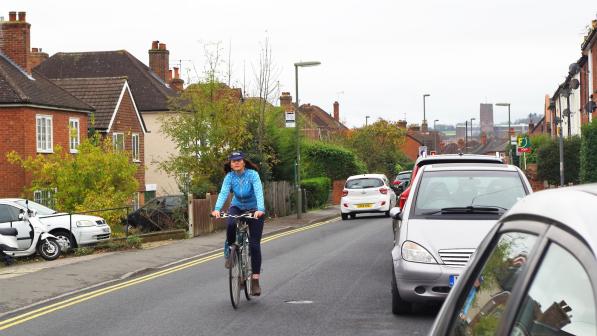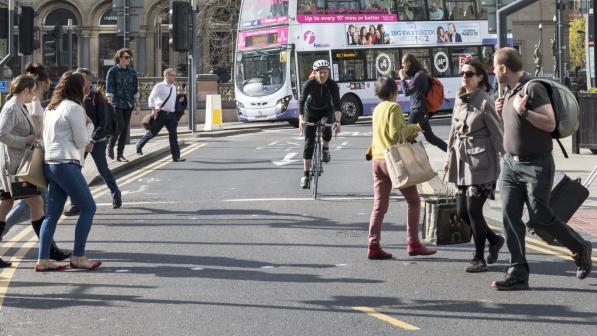How to cycle in traffic

According to the National Standard in cycle training, which is backed by the Department for Transport, there are four core functions of rider behaviour when it comes to cycling confidently:
- observation
- communication
- priority
- position
Let's look at what this might mean in practice.
1. Start with good road positioning
Make sure your road position is not too close to the kerb
Keeping away from the gutter makes you more visible to drivers and helps you miss slippery drain covers, potholes and debris at the side of the road. Also, if someone does overtake you too closely, you have more space on your left to move into.
You may need to ride further out from the kerb if you don’t want a driver to overtake you because it would be unsafe to do so. Some traffic-calming features built out from the kerb, or mid-road refuges for pedestrians, for example, don’t leave enough room for a car to pass a cyclist safely.
Moving into the centre of the lane should mean that drivers stay behind you instead of trying to squeeze past. Some people call riding in the middle of the lane (that is, where motorists normally drive) ‘taking the lane’, or the ‘primary position’.
2. Keep an eye on what’s around you
Road awareness is an important skill to develop
This means looking ahead for rough surfaces, drain covers, road humps, vehicles parked in the lane, potholes and puddles (which can hide potholes). Looking all around also helps you prepare for junctions, roundabouts, traffic lights and so on, and anticipate potential problems. This helps you avoid having to swerve, brake abruptly or make sudden manoeuvres that other road users don’t anticipate
3. Building up a sense of anticipation
All road users have the capacity to do things you might not expect
You can’t control what anyone else does, but you can keep an eye out for pedestrians who aren’t looking where they’re going, dogs not on leads, children kicking a football by the side of the road or drivers with a mobile phone to their ear. Once you’ve registered something or someone with the potential to cause a problem, it is wise to stay on the alert so that you can react as necessary.
4. Make your intentions clear
Try to give other road users an indication of what you’re going to do
Check behind,and if necessary, signal, giving plenty of notice before making your manoeuvre. Manoeuvre only when it is safe. Maintain a position in the lane that stops vehicles undertaking you closely on your left.
If you’re nervous about looking behind and/or taking one hand off the handlebars to signal, it’s a good idea to practise this in a safe, traffic-free environment.
5. Make eye contact
Try to make eye contact with other road users, particularly at junctions, side roads and on roundabouts
Making eye contact may help you work out if the driver has seen you or not, but it’s wise to avoid making assumptions about how attentive they are. Certainly, if you don’t see any reaction assume they haven’t seen you and be ready to brake or steer as necessary.
6. Never pass another road user on the inside
Cycling to work is a safe way to commute to work, but always watch out for left-turning vehicles, as they pose a significant risk to cyclists
Many large vehicles have blind-spots on their passenger side, which means if you are cycling on their left, the driver may not have seen you in their mirrors and make a manoeuvre that puts you at serious risk.
This means you should take great care when approaching the rear of other vehicles and, as a general rule, not undertake them. However, the road layout might mean this is sometimes difficult to avoid. For example, if you are riding in a lane designated for buses, cycles and taxis, and the traffic in the outside lane is stationary or barely moving, you may find yourself passing on the left-hand side anyway.
Similarly, you might find that a vehicle starts to overtake you, but in the end pulls up at traffic lights alongside you before completing their overtaking manoeuvre. If this happens, it might make sense to move past and in front of the it at the lights, making sure if possible the driver has seen you. This can be better than remaining invisible to the driver on the inside of the vehicle by the kerb.
When in the vicinity of a large vehicle, or approaching one from the rear, always assess the situation carefully. Remember it is unwise to assume that a driver has seen you if you have ridden up or find yourself on the left-hand side of the vehicle. Similarly, manoeuvres by large vehicles can be deceptive: just because you haven’t seen anything to suggest that a vehicle is about to turn left, it doesn’t mean that it won’t.
Wherever possible, cycle in the centre of the lane when coming up to traffic lights/junctions so it's not possible to get in a situation of the undertaking in the first place.
7. Watch out for car doors
Give plenty of space around parked vehicles just in case someone opens the door without looking
When approaching a parked vehicle, check behind first to make sure it’s safe, then move out, leaving at least a door’s width when passing just in case someone flings opens a door into your path (an obvious hazard if you’ve just seen the vehicle being parked). While you can’t always see whether there’s anyone on the side you’re intending to pass, it’s worth having a look as you approach, if at all possible.
Encourage others to do the Dutch Reach.
8. Stay visible when riding your cycle in the dark
Make sure you know the law on lighting up
Legally, cyclists are required to have working lights on the front and rear of their cycles, switched on between sunset and sunrise; white at the front and red at the rear. It can, however, be sensible to use your lights in daytime if visibility is poor (in fog, for example) too. If you plan to cycle at night, you are well advised to carry a spare set with you in case your first set fails.
It is also a legal requirement to have reflectors on the rear of your cycle and on the front and back of each pedal.
9. Keep your hands on the brakes
If you can’t get your hands to your brake levers quickly, you might not be able to stop in time if you need to. Cycle with your hands covering your brake levers
Make sure you are ready and able to use your brakes, and that you know how to use them safely. It is usually best to use both brakes at the same time and apply pressure evenly. Take extra care if it is wet, icy or there are damp leaves on the ground, for example.
10. Consider cycle training
Bikeability isn’t just for kids
Whether you’re a beginner or an experienced cyclist, you can benefit from cycle training delivered by a professional instructor. Instructors help you learn more about cycling safely in today’s road conditions, help build your confidence and explain anything that you’re not sure about – getting on an off your bike, changing gears, braking in various conditions, you name it.
